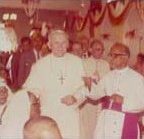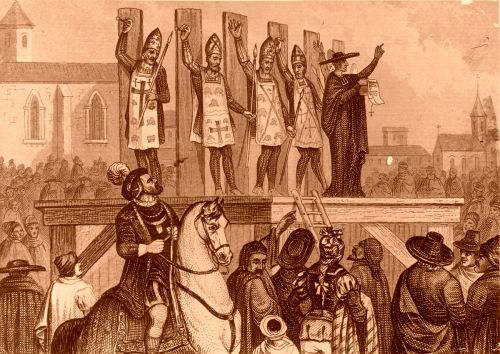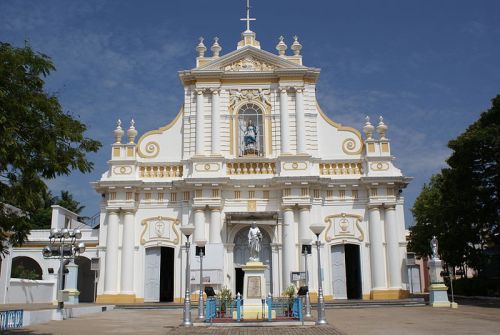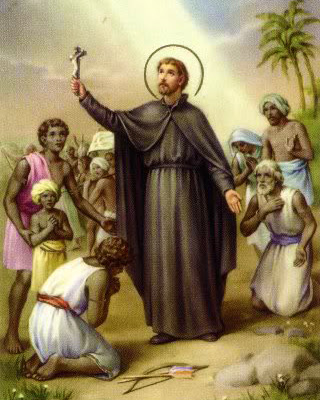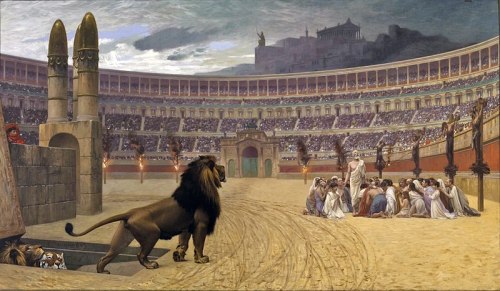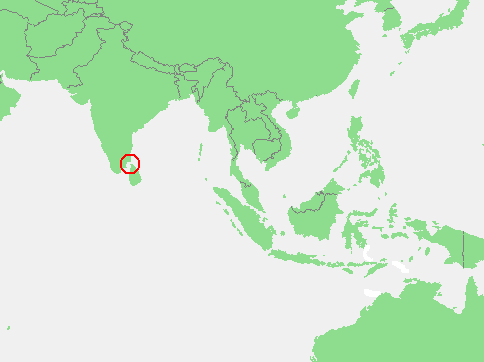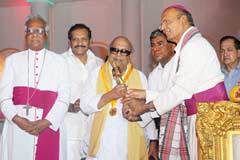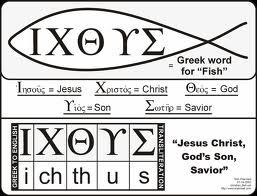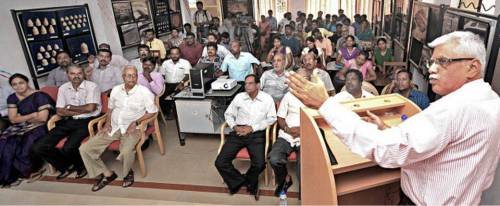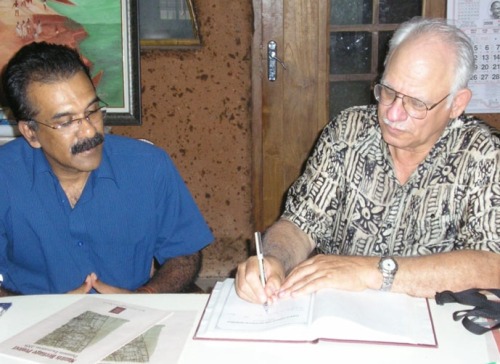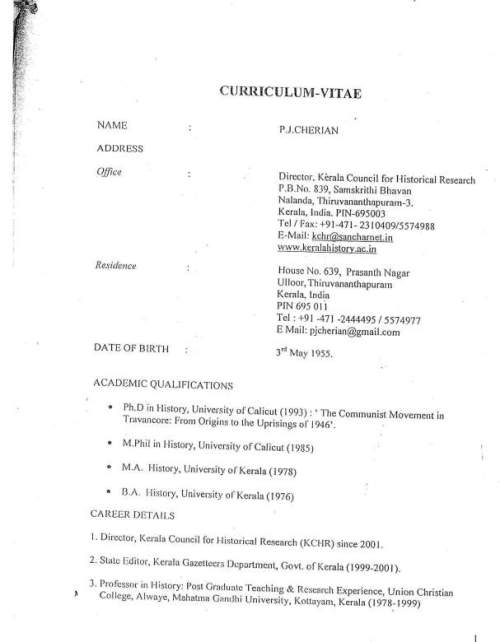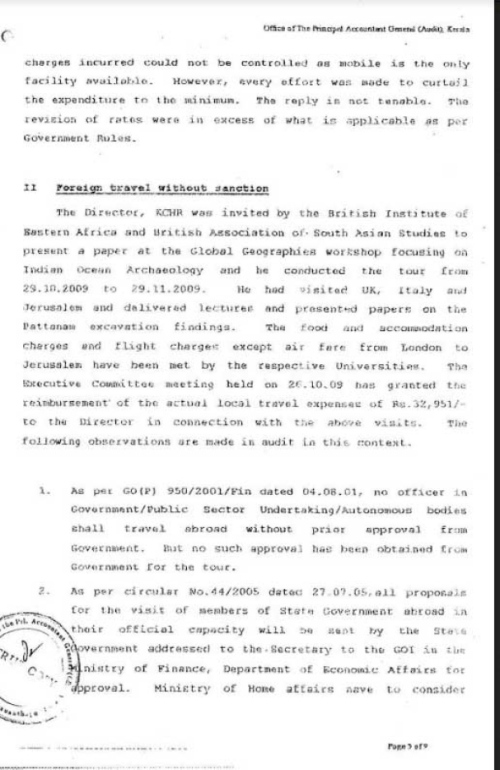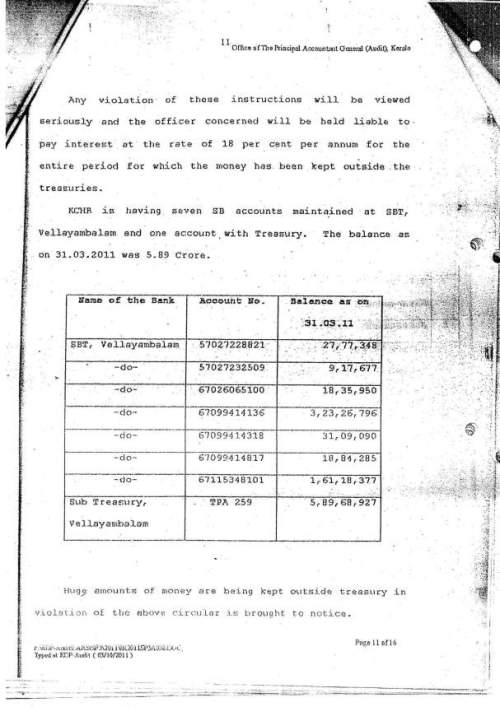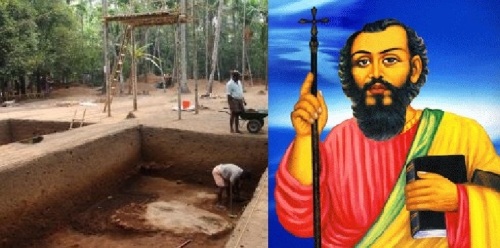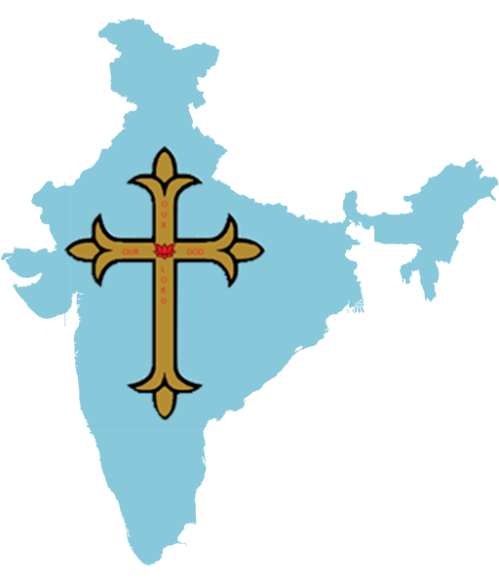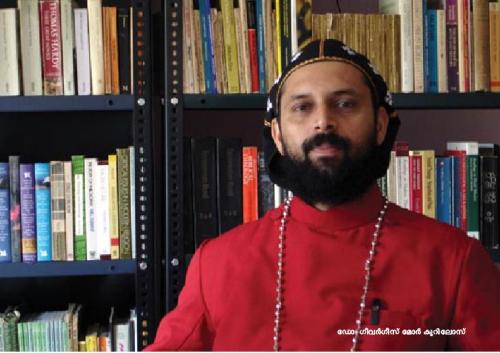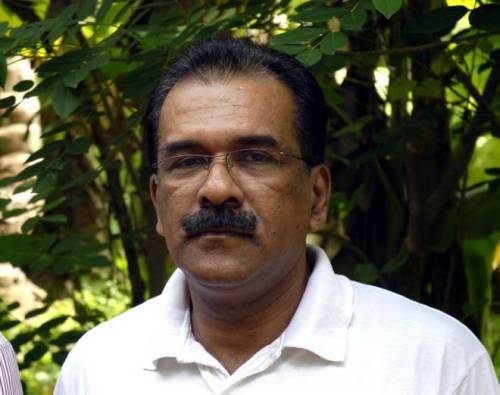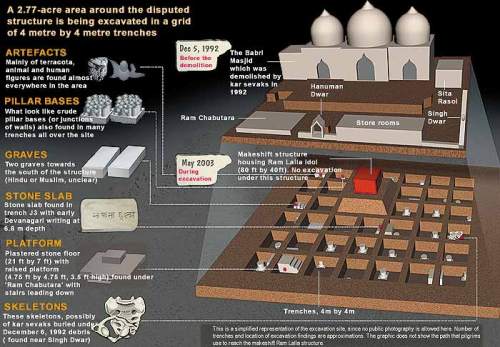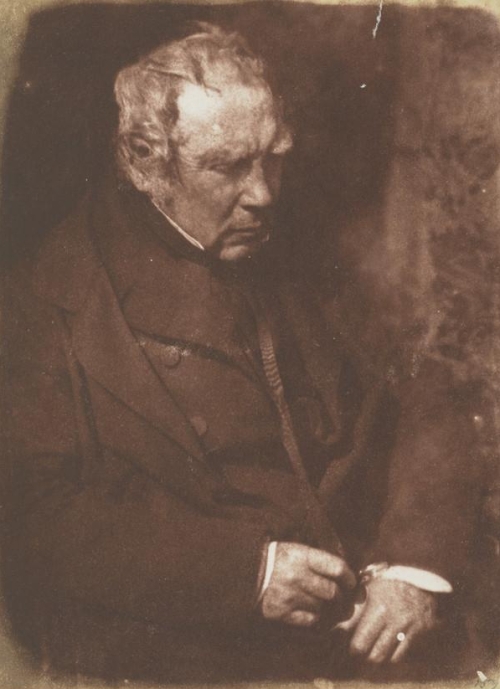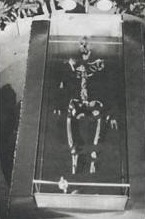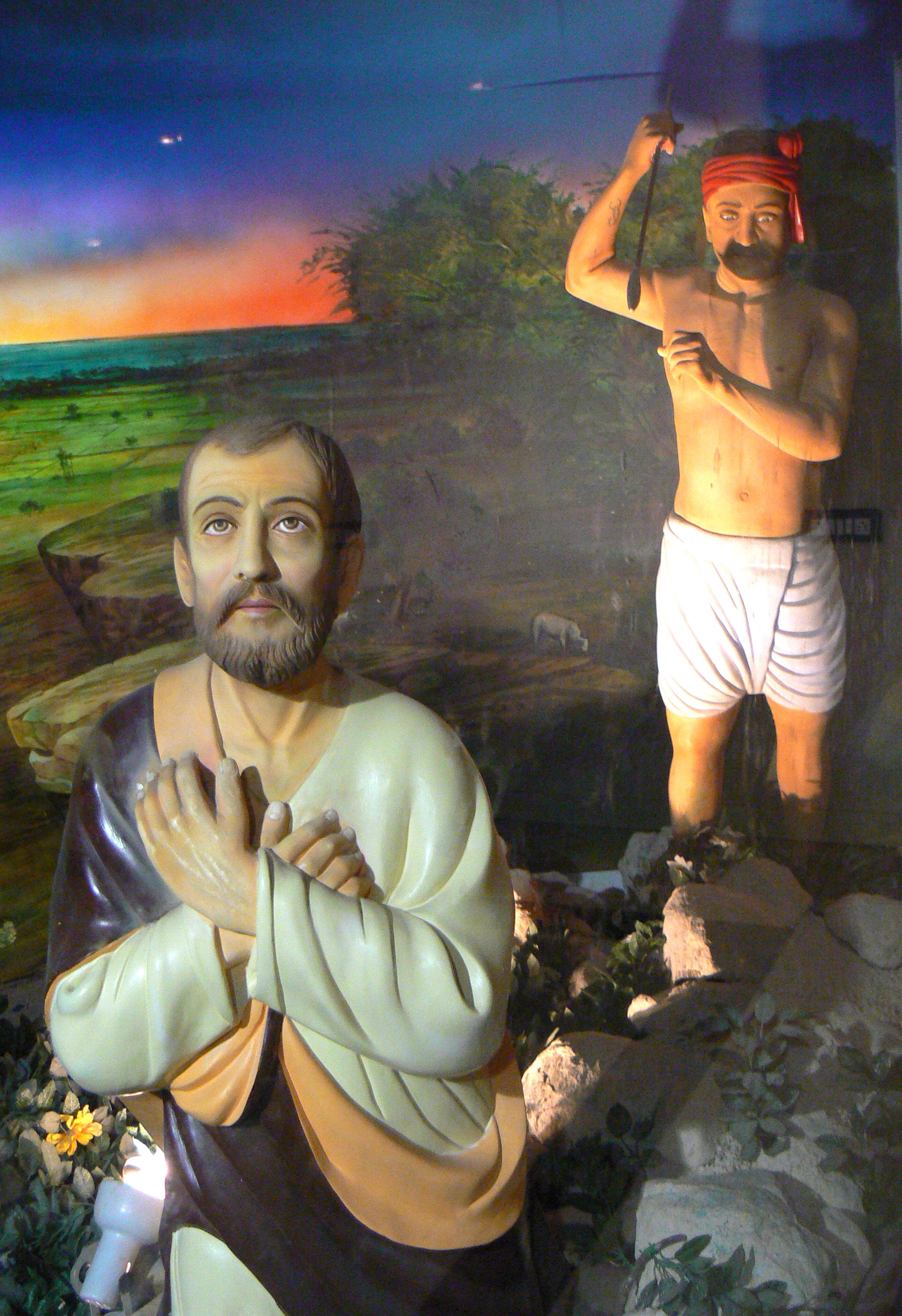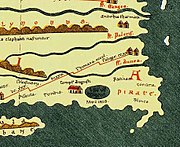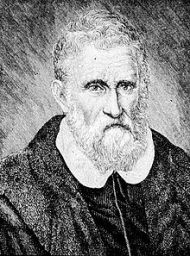The Church and the clergy of different levels—from pope to ordinary pastor—have been involved in spiritual fraud, financial crimes, land scams, rape of nuns and pedophilia, even murder. In India itself it has become the order of the day. Therefore, it is better for the “holy” men of Christ to keep their houses clean and stop falsifying Indian history. – K.V. Ramakrishna Rao
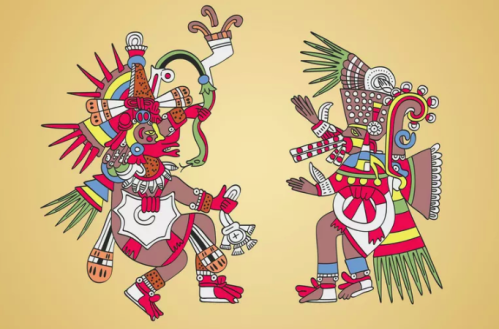
Introduction
As I had participated in conferences related to archaeology, I was reading many books, research papers and related materials during last two months (July-August 2019). At that time, I came across the paper, “Uses of the Past: Archaeology in the Services of the State” written by Don D. Fowler.[1] He was explaining how the Christian myths were manipulated and exploited for religious propaganda and political authority in the Central and South American nations. However, the linking of St. Thomas in that context is most intriguing. When the related literature was studied, it exposed that the Christians wanted to exploit the Quetzalcoatl myth, though historical and archaeological evidences were not there. Some 35 years back, there was a similar situation where the Chennai (Madras) Christians were desperately engaged in a similar exercise. In 1987, I had contacts with Christians[2] and as well as Saivite experts,[3] because of the controversial book written by one M. Deivanayagam.[4] When I was discussing this with Nal. Murugesa Mudaliar, he told many details about the Kapaleeswarar Temple and gave some books also. Actually, the original Kapaleeswarar Temple was on the seashore at the spot where the Santhome Church now stands. Thus, the paper of Don D. Fowler provoked me to read further about the Quetzalcoatl myth. Above all, I find that Thomas Charles Nagy[5] and Henry Jenne[6] have also indulged in propagating such myths under the guise of researchers and history. Incidentally, Ishwar Sharan’s revised edition of the book[7] on the same subject was also published in July 2019. It is not known if all these incidents have been accidental or “God’s plan” to happen together and getting my attraction towards them. Why all these things have been happening?
Colonial historians want native history, historiography and historians as their slaves
As nations started getting independence from the European colonial forces, they knew that the liberated nations would start writing their own histories. Thus, the colonial historians devised historiography with which they tried to perpetuate, propagate and protect their colonial past, so that the liberated native nations would again be confined to dictated research methodology, incarcerated historiography and enslaved history continued. Ironically, religion also played a crucial role with engaged historians, outsourced archaeologists and contracted experts. Thus, it is found that new myths were created, relics manufactured and histories tampered, just like what was happening in the medieval period. As the liberated nations or countries should be continued to be exploited, subjugated and demoralized, they wanted the native religion, culture, tradition, heritage, civilization and all other connected factors disparaged, denigrated and forgotten soon. During their conquest they destroyed the evidences of the past, as happened in the New World or such vandalism continued slowly by them in other countries. The smugglers would be stealing all the ancient historical evidences. Thus, the newly floated myths would be continuously appearing in the print and electronic media, as if that is very important to the native people. The St. Thomas myth appearing in different nations, countries and continents during the last 70-100 years have been attractive, fascinating and amazing. Interestingly, it was planted at places separated by thousands of kms distance and operated effectively.
Mary, Jesus and Thomas appear, disappear and get venerated differently in all the continents without any resemblance
That the Thomas myth was found in the New World has been intriguing, surprising and amazing also.[8] It was found in South America and South India. As the Catholics had been experts in creating myths, according to legend on December 12, 1531, the Virgin Mary appeared in the form of the Virgin of Guadalupe. In fact, they themselves had been wary in manufacturing many virgins.[9] Though, the “idolatry” is denied and theology discussed, they have not bothered about the fake relics manufactured and pictures and idols added with the multiplication of “Our Lady” in various sizes, shapes and facades.[10] So also, Jesus Christ and his “didymus” have been. As they claim,
“Our Lady of Guadalupe, also known as the Virgin of Guadalupe, is a Catholic title of the Blessed Virgin Mary associated with a Marian apparition and a venerated image enshrined within the Minor Basilica of Our Lady of Guadalupe in Mexico City.”
The issue was discussed in 19th century realizing the reality. Thus, one Catholic priest cautioned.[11]
“We do not pretend that the arguments given are incontrovertible. But it cannot be denied that they give to this opinion such a degree of probability that, until stronger arguments are produced against it, it cannot justly be underrated.”
The head or the tail, we always win type position is followed in their interpretation.
How the St. Thomas myth was planted in Mexico
David Brading[12] detailed as to how the Thomas myth was planted in Mexico. Fray Servando Teresa de Mier, an exiled Dominican priest, declared that St. Thomas the Apostle, known to the Indians, i.e., American Indians not Indian Indians, as Quetzalcoatl, had preached the gospel in Anáhuac and had brought with him a cape on which the Virgin Mary had miraculously imprinted her image of Guadalupe. This is a reversal of the legend that Mary dropped her girdle to Doubting Thomas. St. Thomas had introduced the Christian religion into Mexico, since, as Mier exclaimed, “What was the religion of the Mexicans but Christianity confused by time and the equivocal nature of the hieroglyphs?” Milanese nobleman Lorenzo Boturini Benaducci, who had discovered any number of codexes and manuscripts dealing with the civilisation of ancient Mexico banished the devil from any historical role and found evidence of the presence of St. Thomas in the form of Quetzalcoatl. His work had immediate effect, as can be observed by the unpublished history of his Mexican disciple, Mariano Veytia, who equally espoused the identification of Quetzalcoatl as St. Thomas. They are discussed below.
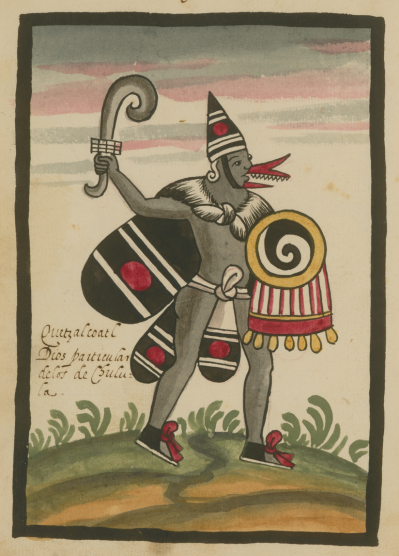
The syncretism of Tonantzin-Guadalupe and St. Thomas-Quetzalcoatl[13]
Initially, they floated a story that Jesus was Quetzalcoatl and then changed and started equating him with Doubting Thomas. Thus, it was believed that St. Thomas who, before the arrival of the Spaniards in America, had already begun to evangelize the New World. This myth was used to serve as a link between the old pre-Hispanic beliefs and the convictions of the colonial Christian world.[14] The myth of Quetzalcoatl is one of the best known and diffused in pre-Hispanic societies of Mesoamerica. The word Quetzalcoatl means in Nahuatl “the feathered serpent” and the creator of indigenous values, having donated agriculture and corn. Serpent and peacock were also added. In Mylapore, the peacock myth exploited, exposed the Catholic trick and hoax, had failed miserably. According to the idea of St. Thomas / Quetzalcoatl validated not only biblical accounts, but also justified divine action. It was hard to understand that God had forgotten crowds of people in different parts of the earth and search for the origin of myths at different places. “The answer was then Quetzalcoatl / St. Thomas,” curtly commented Rubén Torres Martínez.
Catholic nationalism vs pre-Hispanic nationalism
Rubén Torres Martínez gives these details: The myth of St. Thomas / Quetzalcoatl would be controversial because of the speech of Brother Servando Teresa of Mier Noriega y Guerra (1794) who took over the study of Jose Ignacio Borunda, Clave general of interpretation of the Mexican hierarchies (1792?). Borunda relied on a hermeneutic exercise to ensure that St. Thomas was actually Quetzalcoatl, and that the image of the Virgin of Guadalupe was drawn on the layer of the apostle. However, the myth of Quetzalcoatl / St. Thomas remained and spread rapidly in various sectors of the population. The Virgin of Guadalupe will quickly find its place in the Mexican social imagination. It will be, in its own right, one of the founding elements of the new Mexican identity. But the myth of Quetzalcoatl will not have the same importance, at least during the 19th century. By the beginning of the 20th century the debate on the myth of Quetzalcoatl / St. Thomas were taken over by the revolutionary Mexican state. During the colonial era, it was the myth of the Virgin of Guadalupe that had ensured a certain Catholic nationalism. With the myth of St. Thomas / Quetzalcoatl, there was an attempt to form both Catholic and pre-Hispanic nationalism. However, the image of St. Thomas has disappeared, but that of Quetzalcoatl has managed to stay. Today, the Catholics claim that the myth of Quetzalcoatl has become part of both Catholic and Mexican nationalism.
Quetzalcoatl-Jesus myth to Quetzalcoatl-Thomas myth
The Catholic priests taking special interest in Quetzalcoatl, tried to equate him with Jesus, but because of an “unsettling chaos of Christianity”, they debated whether Quetzalcoatl was the devil or a Christian evangelizer, perhaps even the Apostle Thomas. According to biblical narratives, Thomas was twin of Jesus and hence known as “Didymus”. To support “Didymus”, they picked out the duo or twin found in the myth of Popol Vuh. According to legend, the father, Hun Hunahpu, and his sons, particularly his namesake Hunahpu, are related to maize and may be designated as maize gods. In the Popol Vuh the twins’ association with maize is described. Importantly, David H. Kelley presents[15] additional evidence from the Popol Vuh that Hun Hunahpu and the maize god are one and the same. Many stories were there about the twins. For example, in the Popol Vuh, the hero twins’ bones were ground like maize, thrown into a river, turned into fish, and eventually resurrected. These were treated as punishments, generally as a part of persecution, so that anybody could become martyr and so on to fit into the Christian martyrology.

St. Thomas: Chosen apostle for the New World
The assertions made about the apostolate of Doubting Thomas have been significant to note in the context of myth-making. Sarah Enright[16] gives these details,
“St. Thomas, who went east to ‘the Indies’, seemed to be the only Apostle that could have reached the New World. When priests looked through Mesoamerican mythology for a figure that resembled a prophet, Quetzalcoatl stood out as the most likely candidate.”
Lafaye[17] gave a detailed history of how St. Thomas was chosen through a process of elimination as the most likely candidate for having been the Apostle of the Americas…. Among the missionaries, the Jesuits, who arrived to the New World in 1572, in particular supported the Quetzalcoatl-St. Thomas version of the story. They tried many ways to protect the indigenous peoples from being enslaved, and developing the Quetzalcoatl-St. Thomas myth was convenient for this objective. Had he been chosen for the New World, as per the “divine plan”, his myth need not have been transferred to Chennai (Madras).
Jesuits spread the Thomas myth, wherever they went
The Apostle of the Americas gained popularity in the mid 1600s, when priests were searching for more proof to support the story about the appearance of Our Lady of Guadalupe, also known as Mary, the mother of Jesus Christ, to Juan Diego in 1532. In 1662, there was an initiative to ask the Pope to recognize the growing cult of Our Lady of Guadalupe, and while a majority of priests focused on gathering details about the miracle of Juan Diego’s vision of the Virgin Mary, some apparently believed that the appearance of an apostle in the Americas would further validate the story. Thus, the Vatican intervention and support were found in promoting such myths. Again, the Jesuits were especially interested in the apostle. How then, other groups of Jesuits were engaged in manufacturing evidences to plant the Thomas myth is not known. Whether they did not have co-ordination or co-opt, collaborate and collude to produce such myths, wherever, they went.
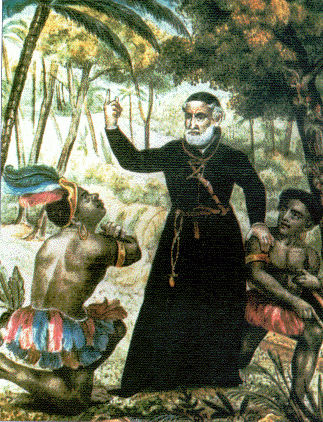
Doubting Thomas in Brazil
They wrote often about traces of St. Thomas in the New World, which include a set of footprints he left in a rock in Brazil. The Jesuits discovered the presence of Thomas in Mexico and as well in Brazil separated by a distance of 6920 kms. In the case of Quetzalcoatl myth, his presence at Mexico was dealt with by equating him to Jesus first and then to Thomas. In Brazil, he was identified with footsteps found at Etaoca. The appearance of St. Thomas was important because it showed that Christianity had a history in the New World prior to the conquest, which meant that the Americas had always been spiritually equal to Spain. Lafaye says,[18]
“… the creoles preferred Saint Thomas, who redeemed their American patria from the stigma of having lain in darkness for sixteen centuries, isolated from revelation.”
About the footprints, Robert Southey[19] gives the details,
“We came to a place called Etaoca, that is to say, the stone-house; as strong a thing I never saw, for it was a great huge rock, and it hath an entrance like a great door within it as any hall in England. The Indians say, that St. Thomas did preach to their forefathers there. Hard by standeth a stone as big as four great cannons, and it standeth upon the ground upon four stones, little bigger than a man’s finger, like sticks. The Indians say that it was a miracle which the Saint shewed them, and that that stone had been wood. Likewise, by sea-side there are great rocks, upon them I saw great stone of prints of the footing of bare foot; all which prints were one bigness. They say that Saint called flashes of the sea and they heard him.”
Now, in 2014 / 2017, Nagy[20] mentions it. Thus, the myth has been perpetuated from 19th to 20th centuries without any concern about archaeological dating, verification of evidences and the historicity attached to them. However, historians like Francisco Javier Clavijero[21] refuted these myths, as they had no evidences. In any case, such myths have no history, but are hagiographical notes, recordings and writing of Christians. One quotes the narrative and the other quotes the first as authority. Then comes, the third to quote the second as authority. Thus, the quoted quote is carried on and finalized as established fact. This has been the methodology of the Christians to write histories for the apostles.
Myth-making activities went on with the blessings of the Vatican
Incidentally, the whole Christian research has been based on Codex Vaticanus documents preserved at Vatican. Both the early priests and the conquistadores believed that the indigenous religions were heretical. While Juan de Zumárraga, the Apostolic Inquisitor of Mexico in 1535, ordered the destruction of all of the pictorial manuscripts in Texcoco, Cortez and his troops defaced all of the religious monuments, idols, and images that they encountered on their way to Tenochtitlan.[22] In the same way, there have been the documents about the Thomas myth manufacturers. However, when the Portuguese demolished the Kapaleeswarar Temple on the seashore, there were no records about the quantum of destruction of temples and manuscripts. When Acharya Paul met the Pope[23] along with the Madras Catholic delegation in 1977, and made his claims about the early Christian origins in Tamil Nadu, evidently, the Pope had already verified and thus did not show any interest. Here the point is that such activities had the blessings of the Vatican, though other non-Christian researchers could not have access to the Vatican documents and the transactions of the Madras Archbishop Arulappa. As Arulappa went to court, some documents came out in public and thus, people came to know about the fraud of creating myth, manufacture of fake palm leaves, copper plates and other documents.[24] The illegal excavations carried out at the Parangi Malai (St. Thomas Mount) were also revealed through the book of Arulappa. The contrast has been, while the natives were asked to reproduce the destroyed ones in Brazil, here in Madras, forged documents were ordered to be produced.
Jesus-Quetzalcoatl Myth
There have been researchers who held that Jesus Christ and Quetzalcoatl are the same individual.[25] Probably, as they wanted to insist on their “Jesus in America” theory, such works continued. The supporters of the myth pointed out that,[26]
“Among those mentioned in post–Spanish conquest manuscripts were that Quetzalcoatl was the Creator, that he was born of a virgin, that he was a god of the air and earth (in his manifestation as the Feathered Serpent), that he was white and bearded, that he came from heaven and was associated with the planet Venus, that he raised the dead, and that he promised to return.”
However, they realized the weakness of myth and manipulation of records during more than 1000 years leading to many mismatches. The physical evidences available for Quetzalcoatl have been specific and historical, whereas, for Jesus, they are unhistorical. However, because of discrepancies, the hypotheses and theories were changed and thus, instead of Jesus, Doubting Thomas was brought in. Yet, the Jesuits were playing tricks in India also.
South Indian myths expose the Christian manipulations and forgeries
Indian myth started with Vasco de Gama in 1503, because of his mistaking of “Mari”, the Hindu goddess, with “Mary”. In the Mylapore or Cranganore myth, there was no Mary or Guadalupe. In 1599, Claudius Buchanan came to verify the “evidences” for the Thomas myth, but he found that all were fake. After his visit to Diamper, the books not favourable to Christianity were reportedly burnt. However, Buchanan recorded that he deposited some copper plates, though fake, with the Cambridge University (see below for details). Later, they tried to exploit Mari / Bhagwati Amman, the Indian goddess and even tried to equate her with Mary, but utterly failed as the Indian Christian theologians and Church historians did not bother about any historical and archaeological evidences.[27] Ironically, whatever evidences they did produce to support their floated myth turned out to be fake and forgeries dated to medieval and even 17th-19th centuries. But their shocking attitude has been to use and quote such forgeries. Incidentally, in India, they could not produce any twin to satisfy the Didymus story! The European Christologists, historians and experts started proving that Jesus was a myth, that Christ, a legendary character copied and derived from eastern gods, and JesusChrist was a creation later involving and accommodating many myths. It is intriguing to note why they were / have been engaged in equating the Quetzalcoatl myth with that of Jesus and then Thomas. Had they been satisfied with the Acts of Thomas and the tomb located in Mesopotamia, then their myths could have been developed and tallied to some extent. The Acts of Thomas says the following:[28]
- And when he had thus prayed he said unto the soldiers; Come hither and accomplish the commandments of him that sent you. And the four came and pierced him with their spears, and he fell down and died.
- And all the brethren wept; and they brought beautiful robes and much and fair linen, and buried him in a royal sepulchre wherein the former (first) kings were laid.
- And he went and opened the sepulchre, but found not the apostle there, for one of the brethren had stolen him away and taken him unto Mesopotamia.
And thus, the Mesopotamian legends would help them to fix the Thomas myth and settle it once for all. Of course, they have Thomas tombs at Edessa, Ortona and Patmos venerated by the respective believers.
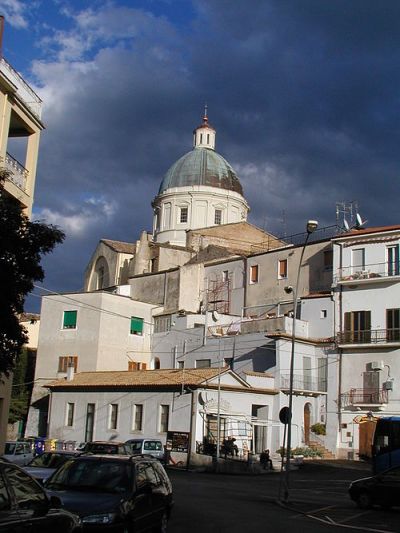
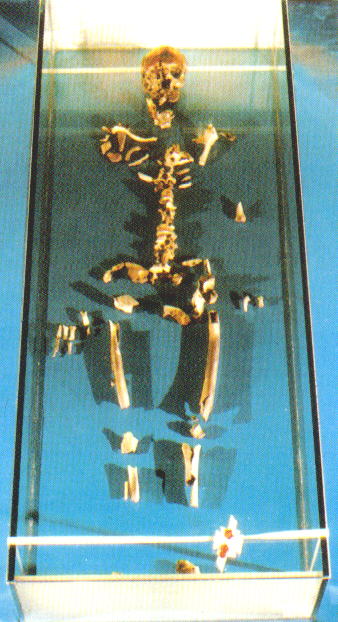
The relics of Thomas were in Italy only
In the pursuit of truth and the Doubting Thomas in the art of early modern Italy, Erin Benay[29] gives many interesting details. Thomas’s relics were later transported to the Isle of Chios in the Aegean Sea. Although the details of this transfer are mysterious, it is clear that in 1258 the Prince of Taranto raided Chios and had the relics brought to the small port of Ortona, Italy. Thereafter most of St. Thomas’s body has remained in the Ortona Cathedral, although there are notable exceptions: Thomas’s jawbone is preserved in the Scuola dei Mureri at San Samuele, Venice, where the guild of builders commissioned Cima da Conegliano’s Incredulity of St. Thomas to adorn their chapel altar. In addition, Cardinal Tisserant arranged for Thomas’s arm bone to be brought to Cranganore (Kodungallur) in 1952; Although Ortona was a major port until its destruction by the Venetians in the 15th century, the interior of the 12th century cathedral is largely ruined today due to bombings during World War II. Emilia Polidoro and Paula Pasquini,[30] contributors to the volume cited above, both suggest that Marco Polo and his contemporaries’ accounts of Thomas’s tomb in India are fictitious and instead favor the Latin version of the Acts of Thomas which describes the transfer to Edessa. Pasquini notes the account of Guglielmo di Tiro who reports that Thomas’s relics were in Edessa as late as 1142, but it is unclear why this traveler’s observations would have any more validity than Marco and his fellow explorers.

Suppression of facts, excessive negationism, and bias
Even after the Arulappa vs Acharya Paul case, the Church writers have been unrelenting and still engaged in bringing out unblushing stories on doubting and doubtful Thomas. The thesis of Thomas Charles Nagy has been the recent glaring example. Vedaprakash[31] has been the first researcher to bring out the facts of Christian manipulations in a book in 1989 in Tamil. This was necessitated when they printed such myths in the state text books. Then, Ishwar Sharan brought out his book in 1991 in English drawing the attention of many. Nagy mentions S. Muthiah, Sita Ram Goel and Ishwar Sharan but, does not mention Arulappa, Ganesh Iyer, Vedaprakash, etc. Though, he has friends in Chennai, and interacted with many Catholic bishops, pastors and historians, he could not access them or their documents. Therefore, the suppression of facts, excessive negationism, and bias could be noted in their attitude and writings. As far as Henry Jenne is concerned, he wrote like a traveller but without compromising with the myth of Thomas in both countries.
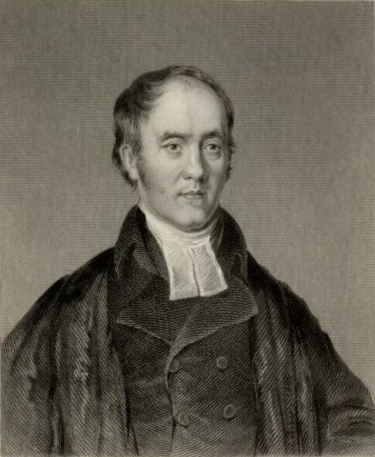
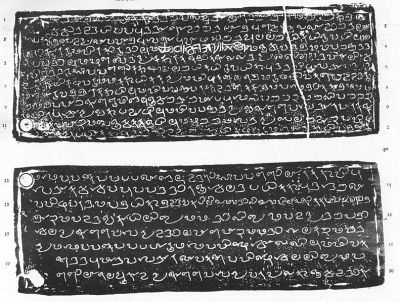
The copper plates and what Claudius Buchanan noted
To explain and expose the position of doubting and doubtful Thomas and his researchers in India, the following example is cited just for illustrative purposes. As the Kerala Christians make much fuss about the copper plates, what Claudius Buchanan recorded about them are noted here. They are as follows:[32]
“But there are other ancient documents in Malabar, not less interesting than the Syrian Manuscripts. The old Portuguese historians relate, that soon after the arrival of their countrymen in India, about 300 years ago, the Syrian Bishop of Angamalee (the place where I now am) deposited in the Fort of Cochin, for safe custody, certain tablets of brass, on which were engraved rights of nobility, and other privileges granted by a Prince of a former age ; and that while these Tablets were under the charge of the Portuguese, they had been unaccountably lost, and were never after heard of. Adrian Moens, a Governor of Cochin, in 1770 who published some account of the Jews of Malabar, informs us that he used every means in his power, for many years, to obtain a sight of the famed Christian Plates; and was at length satisfied that they were irrecoverably lost, or rather, he adds, that they never existed. The Learned in general, and the Antiquarian in particular, will be glad to hear that these ancient Tablets have been recovered within this last month by the exertions of Lieutenant Colonel Macauley, the British Resident in Travancore, and are now officially deposited with that Officer.”
Copper plates script engraved later and none could read it in India
Buchanan continued,[33]
“The Christian Tablets are six in number. They are composed of a mixed metal. The engraving on the largest plate is thirteen inches long, by about four broad. They are closely written, four of them on both sides of the plate, making in all eleven pages. On the plate reputed to be the oldest, there is writing perspicuously engraved in nail-headed or triangular-headed letters, resembling the Persepolitan or Babylonish. On the same plate there is writing in another character, which is supposed to have no affinity with any existing character in Hindoostan. The grant on this plate appears to be witnessed by four Jews of rank, whose names are distinctly engraved in an old Hebrew character, resembling the alphabet called the Palmyrene: and to each name is prefixed the title of ‘Alagen’, or Chief, as the Jews translated it.
“It may be doubted, whether there exist in the world many documents of so great length, which are of equal antiquity, and in such faultless preservation, as the Christian Tablets of Malabar.
“The Jews of Cochin indeed contest the palm of antiquity: for they also produce two Tablets, containing privileges granted at a remote period; of which they presented to me a Hebrew translation. As no person can be found in this country who is able to translate the Christian Tablets, I have directed an engraver at Cochin to execute a copper-plate facsimile of the whole, for the purpose of transmitting copies to the learned Societies in Asia and Europe. The Christian and Jewish plates together make fourteen pages. A copy was sent in the first instance to the Pundits of the Sanskrit College at Trichiar, by direction of the Rajah of Cochin; but they could not read the character.
“From this place I proceed to Cande-nad, to visit the Bishop once more before I return to Bengal.”
Analysis of Buchanan’s notings of the copper plates
A careful reading of Buchanan proves the following facts:
- Even during 16th century, manufacturers of copper plate inscriptions were available.
- They could manufacture the required copper plates even if they could not read the script they inscribed. In other words, they engrave as pictures and not as script or other details.
- Who suddenly produced the copper plates for Buchanan is intriguing?
- Buchanan made copies and circulated them for getting translation.
- He also sent copies to London.
- Original copper plates were not available.
- Therefore, the Portuguese must have manufactured the copper plates.
About the claimed relics throughout the world
About Thomas everything has been doubtful and doubting only, as none knew or knows specifically anything about him.
- His birth and death are not known.
- How he died: Not known.
- Whether he was killed or died: Not known.
- If killed by sword, lance, spear, staff or any such thing: Not known.
- Where died: Not known.
- How many bodies and skeletons: Not known.
As he was having many bodies, skeletons and tombs, he must not have been a human being, just a myth. As there has not been any specific day or date for the death of Thomas, Christians celebrate him on various designated days:
- First Sunday after Easter,
- October 6,
- June 30,
- July 3,
- December 21,
and so on, as none knew him or his whereabouts. Archeologists could easily date the relics and find out the truth. Here, in Chennai (Madras), from the writings of the Europeans, it has been proved that all relics, paintings and sculptures belong to the medieval period and thereafter. As the Portuguese demolished the original Kapaleeswarar Temple at the seashore in 1523, the dates tally. To add a tail piece, before concluding, the following is quoted,[34]
“The relics enclosed in some of them comprised a portion of the milk of the Virgin Mary, parts of the skulls of St. Bartholomew and St. Thomas the Apostle. … A shirt of St. Thomas the Martyr, a white girdle given by St. John the Evangelist to St. Mary, and a small part of the skull of St. Thomas the Apostle, and a candle end of the Virgin Mary.”
Forced propaganda carried on
As I have been attending hundreds of conferences being a life member, executive member of IHC, SIHC, APHC, TNHC, AIOC and “scientific and secular history” is always claimed, it is a wonder as to how this type of mythistory, biased historiography and historiographical methodology could go on in spite of exposures of fakes, forgery and frauds. Ironically, no historian, archaeology or connected expert questions such myth-making, fake relic manufacturing and subversive forcing of such stuff on the students and public. All this proves that something is wrong somewhere and the involved do not bother for anything, as they want to do only propaganda at any cost. As the propaganda should continue for years, they think that such myths, myth-making, fake manufactures and bogus archaeology get legitimised by force and thrust. Only there would be few to expose the truth, but they can be suppressed and people forget soon. Before another finds out and cries, already there would be more relics, more fake evidences and books.
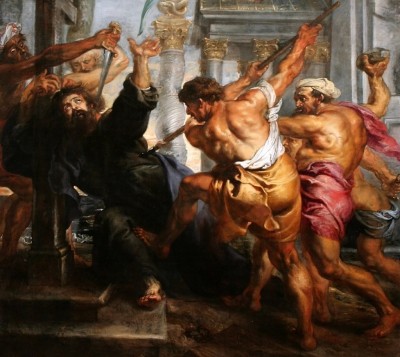
Conclusion
Actually, Indians do not care about the belief system of others, as they respect all considered as “divine”. Nowadays, as non-Hindus and such categories have started criticizing and attacking Hindu belief systems, Hindus started analyzing the non-Hindu belief systems. Ironically, the non-Hindus have only been joining with atheists and anti-Hindus, and started attacking Hindu belief systems. Thus, in the context, the following observations are made as a conclusion:
-
- Historically, whether Jesus existed or not is not an issue for Indians or Hindus. In fact, only European and non-Indian historians, archaeologists and researchers have proved that such a personality never existed.
- Jesus, Christ and Jesus Christ have been three different concepts and thus they are mythical. It is not a problem for Indians.
- Therefore, whether such a mythical character had 12 apostles or many more is also left for them to decide as to whether it is myth or otherwise.
- The Acts of Thomas claims that Thomas was killed by the soldiers of Ghondoporus and buried in Mesopotamia and therefore his burial of the body at another place or places is ruled out.
- A human being, if he at all existed, could have only one body and skeleton and therefore, discovering many tombs, skeletons, and more than one skull proves that many forgeries, fakes and duplicates have been created or the skeletons and bones belong to other unknown persons.
- Thus, the many narratives and stories show that one myth is created based on another myth and so on. Thus, the myth-making has led to lies, forgeries, and frauds and that is what has been happening till today.
- The writers involved have not been bothered about history, historicity, historical evidences, or cross-checking the evidences claimed.
- As far as Chennai (Madras) is concerned, the case of R. Arulappa vs Acharya Paul alias Ganesh Iyer has exposed the Church, the archbishop and others involved directly in the manufacture of evidences for a Thomas myth, and all have been caught red-handed.
- The involved persons have become desperate and controversial, indulging in divisive communal politics to hide their ugly practices.
- Above all, the Church and the clergy of different levels — from pope to ordinary pastor — have been involved in spiritual fraud, financial crimes, land scams, pedophilia and rape of nuns, even murder. In India itself it has become the order of the day. Therefore, it is better for the “holy” men of Christ to keep their houses clean and stop falsifying Indian history.
1. Fowler, Don D., “Uses of the Past: Archaeology in the Service of the State”, American Antiquity, CUP, Cambridge, April 1987.
2. Hrudhayam, Ignatius; Francis, T. Dayananda; Kulandai, Swami; Carvalho, Selvaraj; et al in connection with inculturation as well as the St. Thomas myth in Mylapore.
3. Mudaliar, N. Murugesan & Mudaliar, Arunai Vadivelu. The former taught me Saiva Siddhanta and later wrote the rebuttal against the Deivanayagam book. See news item.
4. Deivanayagam, N., He wrote and published Viviliyam, Thirukkural, Saiva Siddhantham inviting challenge from the Saivite scholars. Arunai Vadivelu Mudaliar wrote the rebuttal book.
5. Nagy, Thomas Charles, Catholic Shrines in Chennai, India: The politics of renewal and apostolic legacy, Routledge, New York, 2017. Read thesis online.
6. Jenne, Henry, Entre Trilhos e Estrelas, Chiado Books, 2017 and the English version is published as Between Rails and Stars, United Verlag, 2019.
7. Sharan, Ishwar, The Myth of Saint Thomas and the Mylapore Shiva Temple, Voice of India, New Delhi, 2019. Earlier editions in 1991, 1995, 2010. Read fourth revised edition online.
8. The New World is the name used for North and South America including the islands of the West Indies and Bermuda, Falkland Islands, Greenland, Saint Pierre and Miquelon, South Georgia, South Sandwich Islands and Oceania.
9. Rendino, Stéphanie, Our Lady of Ocotlán and our Lady of Guadalupe: Investigation into the origins of parallel virgins, University of Montreal, Canada, 2008.
10. Cruz, Joan Carroll, Miraculous Images of Our Lady: 100 Famous Catholic Portraits and Statues, Tan Books, USA, 1993.
11. Defouri, J. H., “Was the Apostle St. Thomas in Mexico?”, Catholic World, December 1881. Read article online.
12. Brading, David A., “Myth and Images in Mexican History: Foundations and Legitimacy,” Anales del Instituto de Investigaciones Estéticas, Instituto de Investigaciones Estéticas, Mexico City, 2011.
13. Murray, Tim & Evans, Christopher (Ed), Histories of Archaeology: A Reader in the History of Archaeology, OUP, New York, 2008.
14. Martínez, Rubén Torres, St. Thomas and Quetzalcoatl. An attempt to construct an identity from the rewriting of the myth. See also Gardener, Brant, The Christianization of Quetzalcoatl. Read article online.
15. Kelley, David H., “Astronomical Identities of Mesoamerican Gods”, Archaeoastronomy (supplement of Journal for the History of Astronomy), 1980.
16. Enright, Sara, “Quetzalcoatl: A Mestizo Myth,” Undergraduate Research Journal, 2006.
17. Lafaye, Jacques, Quetzalcoatl and Guadalupe: The Formation of Mexican National Consciousness 1531-1813, UCP, Chicago, 1976,
18. Lafaye, Jacques & Keen, Benjamin (Tr), Quetzalcoatl and Guadalupe: The Formation of Mexican National Consciousness 1531-1813, UCP, Chicago, 1976.
19. Southey, Robert, History of Brazil, London, 1822.
20. Nagy, Thomas Charles, Catholic Shrines in Chennai, India: The politics of renewal and apostolic legacy, Routledge, New York, 2017. Read thesis online.
21. Clavijero, Francisco Javier, Historia Antigua de México, 1780.
22. Carrasco, Davíd, Quetzalcoatl and the Irony of Empire: Myths and Prophesies in the Aztec Tradition, UCP, Chicago, 1982. There are very few resources available that document Quetzalcoatl’s role in pre-conquest Mesoamerican civilization. By the time the Spaniards took an interest in the original culture and belief systems of the societies they conquered, they had already killed most of the indigenous priests and burned all but sixteen of their sacred books. Instead, the Spanish scholars relied on oral histories, on reproduced manuscripts, and on the analysis of the remaining picture codices—so there was a lot of room for misinterpretation, ethnocentric misunderstandings, and manipulation of the text.
23. Paul VI, Known as Giovanni Battista Enrico Antonio Maria Montini, Pope Paul VI died on August 6, 1978.
24. These details came out in local Tamil and English newspapers with photographs.
25. Taylor, John, “Mediation and Atonement,” Deseret News, Salt Lake City, 1882 (for a view that Jesus Christ and Quetzalcoatl are the same individual). H. Roberts came to a similar conclusion in his “New Witnesses for God,” Deseret News, Salt Lake City, 1909–11. See also the booklet by Mark E. Peterson, “Christ in America,” Deseret News, Sal Lake City, 1972.
26. Wirth, Diane E., “Quetzalcoatl, the Maya maize god, and Jesus Christ,” Journal of Book of Mormon Studies, 1992–2007.
27. Bayly, Susan, Saints, Goddesses and Kings: Muslims and Christians in South Indian Society 1700-1900, CUP, Cambridge, 1989.
28. James, Montague Rhodes, The Apocryphal New Testament (including the Acts of Thomas), Oxford, 1924. Read Acts of Thomas online.
29. Benay, Erin. The pursuit of truth and the Doubting Thomas in the art of early modern Italy, Rutgers University, New Jersey, 2009.
30. Polidoro, Emilia & Pasquini, Polidoro, L’apostolo Tommaso è ad Ortona, Ortona, 2006. As quoted by Erin Benay.
31. Vedaprakash, Indiyavil Saint Thomas Kattukkathai (The Myth of Saint Thomas in India), Institute for the Study of Western Religions, Madras, 1989. Read book online (in Tamil).
32. Buchanan, Claudius, Two Discourses preached before the University of Cambridge, on the commencement of Sunday July 1, 1810 and a sermon before the Society of Missions to Africa and the East; at their tenth anniversary. June 12, 1810. To which added Christian Researches in Asia, Cadell, T. & Davies, W., London and Deighton, J., Cambridge, 1811.
33. In a footnote, Buchanan recorded, “Most of the Manuscripts which I collected among the Syrian Christians, I have presented to the University of Cambridge; and (they are now deposited in the Public Library of that University, together with the copper-plate facsimiles of the Christian and Jewish Tablets.” Thus it is evident that there were no originals of the said copper plates and the available / claimed copper plates have no historical value.
34. Tighe, Robert Richard & Davis, James Edward, Annals of Windsor being A History of the castle and town; with some account of Eton and places adjacent, Longmans and Brown, London, 1858.
› K.V. Ramakrishna Rao is a retired tax commissioner, author and historical researcher. He blogs at https://kvramakrishnarao.wordpress.com/.



